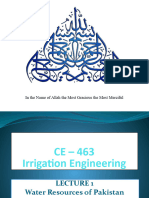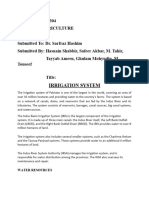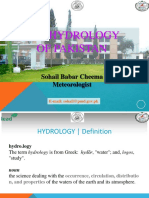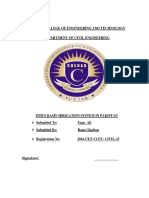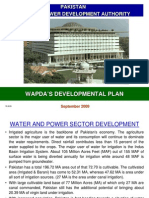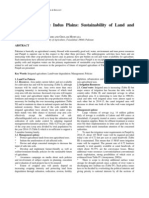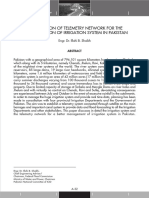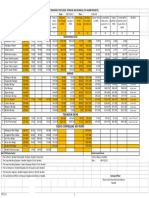2/23/2018
Lecture -2
Water Resources of Pakistan
Planning & Development of Irrigation System
Inundation Canals – Irrigation was undertaken through a network
of inundation canals, functional only during periods of high river
flow. The last inundation canals were connected to weir controlled
supplies in 1962 with completion of Guddu Barrage on Indus River
1859 – Controlled irrigation began with the completion of Upper
Bari Doab Canal (UBDC) from Madhopur Headworks on Ravi River
1872 – Sirhind Canal from Rupar Headworks on Sutlej River
1886 – Sidhnai Canal from Sidhnai Barrage on Ravi River
1892 – Lower Chenab from Khanki on Chenab River
1901 – Lower Jhelum from Rasul on Jhelum River
1885 to 1914 – Lower and Upper Swat on Kabul River & Paharpur
Canals in NWFP were completed
1
� 2/23/2018
Planning & Development of Irrigation System
1907-15 – Ravi River serving a large area of Bari Doab, was
deficient in supply while Jhelum had a surplus. Triple Canal Project,
linked the Jhelum, Chenab, and Ravi rivers, allowing a transfer of
surplus Jhelum and Chenab water to the Ravi. Triple Canal Project
is the key concept for the resolution of the Indus Waters Dispute
between India and Pakistan in 1960
1933 – The Sutlej Valley Project, comprising of 4 barrages & 2
canals, resulting in the development of unregulated flow resources
of the Sutlej River & motivated planning for Bhakra reservoir
1933 – The Sukkur Barrage & its system of 7 canals serving 2.95
million hectares (Mha) of land in Lower Indus were completed
1939 – Haveli & Rangpur from Trimmu Headworks on Chenab
1947 – Thal Canal from Kalabagh Headworks on Indus
Planning & Development of Irrigation System
1947-48 – At independence, the irrigation system, conceived
originally as a whole, was divided between India & Pakistan
without regard to irrigated boundaries. This resulted in the
creation of an international water dispute in 1948
1948-60 – In addition to 3 inter-river link canals, Kotri, Taunsa &
Guddu Barrages were completed on Indus to provide controlled
irrigation to areas previously served by inundation canals
1960 – Indus Waters Treaty under aegis of the World Bank. The
treaty assigned three eastern rivers (Ravi, Beas, Sutlej) to India &
three western rivers (Indus, Jhelum, Chenab) to Pakistan with a
transfer of irrigation supplies from western rivers to areas in
Pakistan formerly served by eastern rivers
1960-71 – The Indus Basin Project including Mangla Dam, 5
barrages, 1 syphon and 8 inter-river link canals
1975-76 – Tarbela Dam started partial operation
2
� 2/23/2018
Domestic, Industrial, Agricultural & Other Water Usages
Source: Food and Agricultural Organization (FAO), United Nations
Domestic, Industrial, Agricultural & Other Water Usages
Source: Food and Agricultural Organization (FAO), United Nations
3
� 2/23/2018
Water withdrawal by source
Source: Food and Agricultural Organization (FAO), United Nations
Indus Basin Irrigation System (IBIS)
4
� 2/23/2018
Indus Basin Irrigation System
Key Facts
Reservoirs 3
Barrages 16
Headworks 2
Link Canals 12
Canal Systems 44
Watercourses 107,000
Length of Canals 56,073 km
Length of 1.65 million km
Watercourses (200 – 800 acres)
Avg. Canal Diversion 104.74 MAF
67.11 MAF – Kharif
37.63 MAF - Rabi
Groundwater 41.6 MAF
Abstraction
Tubewells > 550,000
Irrigated Area 36 million acres
Avg. escape to sea 39.4 MAF
Indus Basin Irrigation System
44 canal systems (Punjab - 23, Sindh - 14, KPK - 5 & Balochistan - 2)
About 77.4% of total irrigated area of Pakistan falls in Punjab, 2.8%
area falls in KPK & 19.8% in Sindh/Balochistan
During kharif periods, Punjab uses 34.3 MAF annually, while Sindh
& Balochistan use 31.4 MAF & KPK used 2.35 MAF
During rabi periods, avg. withdrawals by Punjab, Sindh &
Balochistan, & KPK are 19.87, 16.06 & 1.46 MAF, respectively
Outside the Indus Basin, there are smaller river basins drain
directly to sea. One is on Mekran coast of Balochistan & other is a
closed basin (Kharan). The total amount inflow of both is < 4 MAF
annually. These streams are flashy & do not have a perennial
supply. About 25% of their inflow is used for flood irrigation
5
� 2/23/2018
Water Source Distribution of Irrigated Area
Provincial Irrigation Setups
Punjab
The public irrigation infrastructure in the Punjab consists of 13
barrages, 2 siphons across major rivers, 12 link canals & 23 major
canal systems over an aggregate length of 34,500 km
The whole irrigation infrastructure lies within the IBIS. It serves an
area of 8.58 MHa. In addition, there are 135 surface drainage
systems including over 670 drains, with an aggregate length of
about 6,600 km, which drain an area of about 5.79 MHa, within 23
canal commands
During 1999-2000, the total irrigated area using all sources
available in the Punjab, was of the order of 13.8 MHa. This
included 11 MHa in the canal commands. The private tubewells &
wells irrigated 2.8 MHa during the same period
6
� 2/23/2018
Provincial Irrigation Setups
Sindh
Sindh has 14 publicly owned irrigation systems, which receive
water from 3 barrages across the River Indus. These systems, with
an aggregate length of 18,000 km of canals, serve an area of about
5.38 MHa
There are 13 existing surface drainage systems in Sindh, which
serve a total area of over 3.5 MHa & have an aggregate length of
about 4,800 km. New drains are also being constructed in the
province
During 1999-2000, the total irrigated area, using all sources in
Sindh, was of the order of 3.52 MHa. This included 2.39 MHa of
irrigated land in the canal commands. The private tubewells and
wells irrigated 0.13 MHa during the same period
Provincial Irrigation Setups
KPK
KPK has five publicly owned irrigation systems in the Indus Basin,
which serve a total area of 0.34 MHa. These systems receive water
from two headworks across River Swat and Warsak Dam. In
addition, there are six other canal systems, which serve a total of
0.13 MHa of land
KPK has over 200 canals called “civil canals”, which are community
or privately owned. These irrigate an aggregate area of 0.83 MHa.
There are four surface drainage systems in KPK comprising of 456
drains. These serve a total area of 0.37 MHa
During 1999-2000, the total irrigated area, using all the sources in
KPK was of the order of 0.89 MHa. This included 0.39 MHa of land
in the canal commands. Private canals, tubewells and wells
irrigated 0.47 MHa during the same period
7
� 2/23/2018
Provincial Irrigation Setups
Balochistan
Balochistan has two canal systems, which receive water from IBS
through Guddu & Sukkur Barrage, located in Sindh. These canal
systems serve a total area of 0.33 MHa. One of these, the Pat
Feeder Canal System, has been improved recently. In addition,
there are 431 independent publicly owned small irrigation
schemes, which serve 0.14 MHa. There are a few privately owned
small irrigation schemes too
Balochistan also has one large drainage system called the “Hairdin
Drainage System”, which drains 0.07 MHa
During 1999-2000, the total irrigated area using all the sources in
Balochistan, was of the order of 0.81 MHa. This included 0.4 MHa
in the canal commands. Private tubewells and wells irrigated 0.34
MHa during the same period
Provincial Irrigation Area
8
� 2/23/2018
Groundwater Usage for Irrigation
Large scale tubewell pumpage for irrigation began in early sixties.
Number of private tubewells are presently about 550,000 in IBIS
An estimated 41.6 MAF of groundwater is pumped annually in
Pakistan. More than 90% of the extracted groundwater is used for
irrigation purposes. Groundwater reservoirs are recharged from
rivers, canals, watercourses, farm channels & fields
Most of ground water abstraction occurs in Punjab. This was of
order 34 MAF druing 1999-2000, followed by Sindh at 5 MAF, KPK
at 2.1 MAF & Balochistan at 0.5 MAF
In last 25- 30 years, ground water has become a major supplement
to canal supplies, especially in the Upper Indus Plain. In this region,
ground water quality is good. The groundwater resources of
Pakistan extend from the Himalayan foothills to the Arabian Sea &
are contained in the alluvial deposits of the Indus Plains
Groundwater Usage for Irrigation
9
� 2/23/2018
Salinity & Waterlogging
Pakistan has an agriculture-based economy, which is mainly
dependent on irrigation through canal supplies. Before
introduction of irrigation system, water table was sufficiently deep.
However, due to a lack of drainage facilities & improper water
management, water table rose, resulting in waterlogging & salinity
About 25% of the irrigated area of Pakistan is affected by
waterlogging & salinity/sodicity problems
In addition to other measures like Irrigation System Rehabilitation,
Command Water Management & On-Farm Water Management
programs taken up by different government departments, WAPDA
completed 57 Salinity Control & Reclamation Projects (SCARPs) at
total cost of Rs. 26.48 billion. These cover a gross area of 7.81 MHa.
Surveys indicated that waterlogging has reduced from 42% in 60s
to about 25% in 1977-79. Similarly, saline, saline-sodic and sodic
soils were reduced from 6, 27 &11% to 11, 24 & 3% respectively
Salinity & Waterlogging
The National Drainage Programme (NDP) was launched in 1998,
incurring a cost of US$ 785 million. The programme will continue
for 25 years. The major activities envisaged include:
remodeling / extension of existing surface & new drains
rehabilitation / replacement of saline groundwater (SGW)
tubewells
installation of pipe drains in new areas
lining of watercourses in SGW areas
construction of interceptor drains
reclamation of waterlogged areas through biological drainage
transfer of fresh groundwater tubewells
10
� 2/23/2018
Irrigation Efficiencies
Pakistan, despite being an agrarian country, has demonstrated
extremely low irrigation efficiencies, creating problems related to
water conservation, waterlogging & salinity
The crop yield in Pakistan is on the lower side. The current
estimated irrigation efficiency in Pakistan is 35.5%. This means that
only 35.5% of the water that reaches the fields is actually used by
the crops
Irrigation efficiency is a compound of three efficiencies i.e. canal-
head efficiency, watercourse efficiency & farm/application
efficiency
Escapage to the Sea
On an average, about 39.4 MAF of water flows to the sea annually
Most of this flow occurs during the kharif season when 36.94 MAF
or 93.8% goes to the sea
In the rabi season, on average about 2.44 MAF flows into the sea,
and most of that is in the first few weeks of the season. For several
months in the winter, there is no flow into the sea
During the last 25 years, a total flow of 984.75 MAF of river water
has flowed into the sea. This is equivalent to more than 9 years of
average canal withdrawals during the same period
11
� 2/23/2018
Water Availability VS Population
Reservoir Sedimentation
12
� 2/23/2018
Land Use in Pakistan
WAPDA’s Water Vision 2025
13
� 2/23/2018
WAPDA’s Water Vision 2025
14

